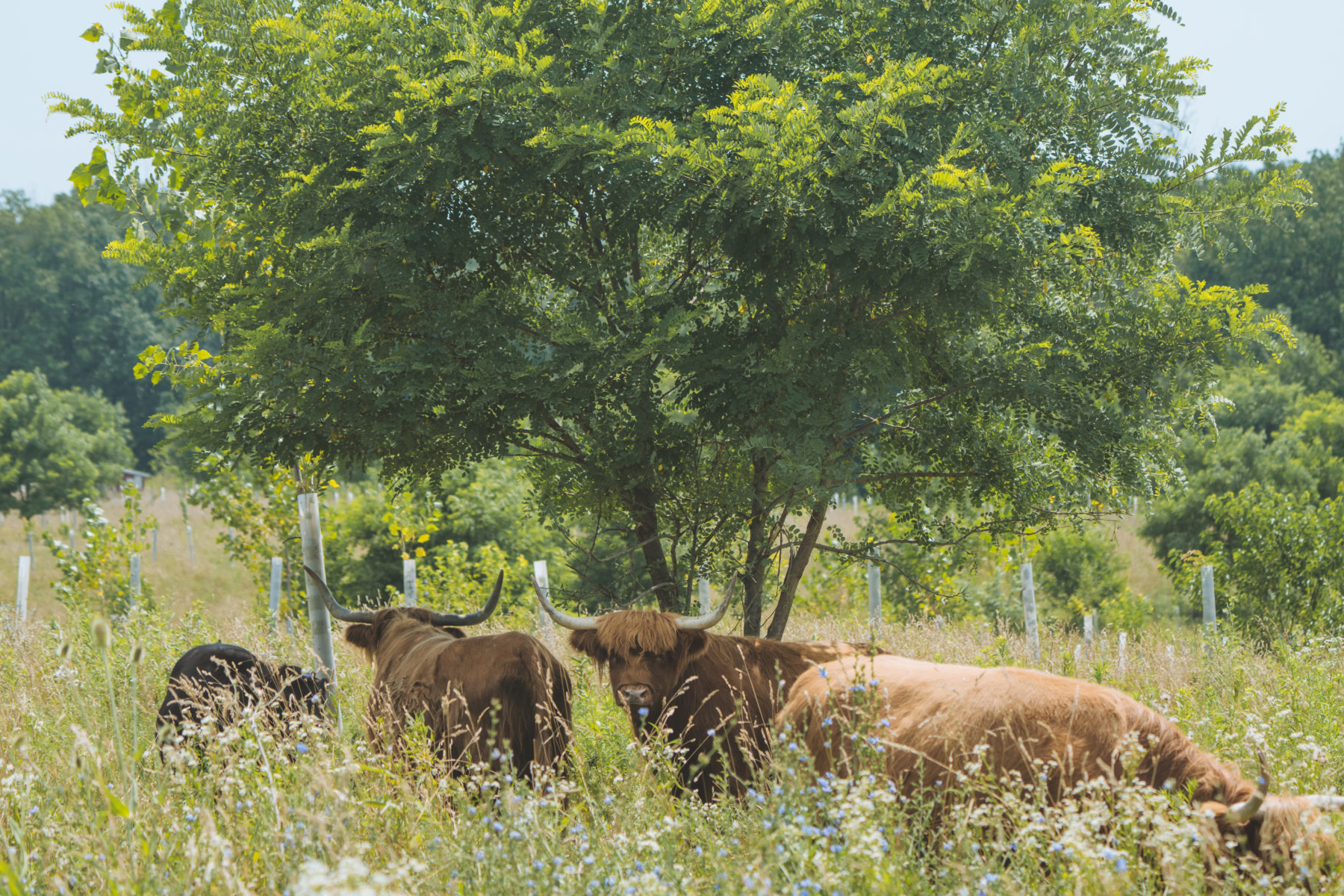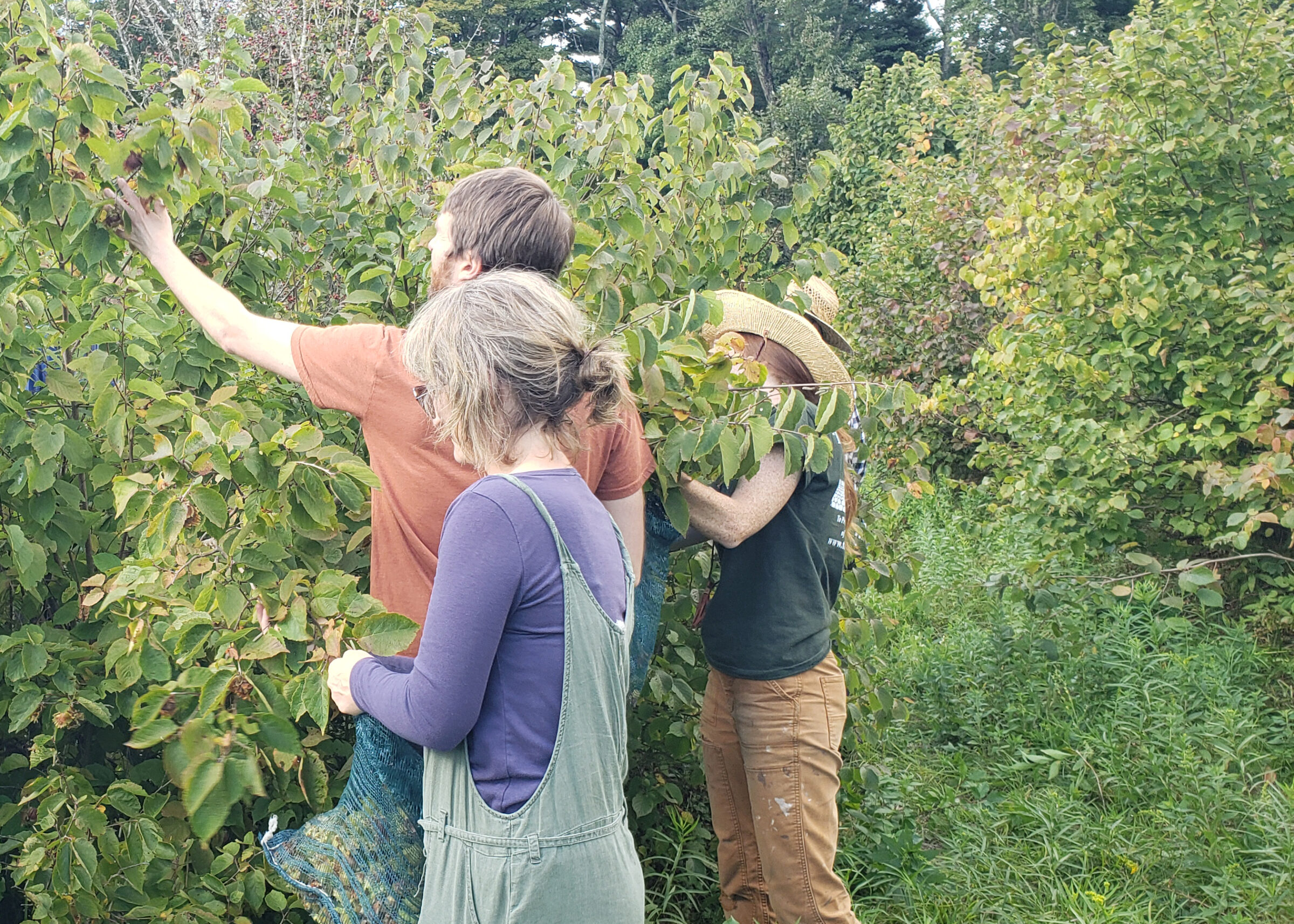
Tree Range Meat: Designing Silvopasture Systems for Grazing Operations in New England
The productive integration of diverse trees and livestock is one of the oldest indigenous agricultural techniques practiced around the world. This system, known in the United States as silvopasture, is gaining significant traction in New England as a regenerative agroforestry farming practice with major potential to diversify local farm ecosystems, improve long-term financial returns, and mitigate climate change. Through a collaboration with American Farmland Trust’s Western New England Regenerative Agriculture Project and financial support from the Natural Resource Conservation Service (NRCS), Regenerative Design Group (RDG) has had the opportunity to work with several forward-thinking farms to design appropriate silvopasture systems that meet on-farm goals for grazing, water management, shade, and fodder production.
Silvopasture in Action

In 2023, RDG worked with the USDA’s National Agroforestry Center in collaboration with Wellspring Forest Farm and Inhabit Films to document the rise of silvopasture practitioners in the Northeast. 145 respondents across 9 states (ME, VT, NH, MA, CT, NY, RI, NJ, PA) reported stewarding 27,000 acres in total, with 5,300 of those acres in silvopasture management. Nine farms were profiled in a 10-part video series available at Farming With Trees, a decentralized network encouraging collaborative projects in agroforestry that is grounded in the wisdom and knowledge of people, communities, and ecosystems.
As more grazing operations learn about the potential benefits of silvopasture, RDG has stepped up to provide one-on-one technical assistance and implementation support tailored to individual farms enrolled in a Regional Conservation Partnership Program (RCPP) that has provided over $15 million in resources and support to livestock farmers in New Hampshire, Vermont, Massachusetts, and Connecticut.
Considering the Overstory
Silvopasture, which can refer either to a pasture planted with shade/fodder trees or a forest appropriately thinned to support intensive rotational grazing, can greatly improve livestock health and production by reducing stress and providing a more diversified and nutritious diet. Trees in open pastures can improve pasture forage quality in dry summers, sequester more carbon than grass alone, and provide the structural diversity that increases habitat for pollinators, birds, and wildlife. Managed forest grazing can improve the profitability of timber stands, increase soil health and fertility, and reduce the spread of less desirable species.
As the climate continues to change and shift long-standing soil and hydrological regimes, trees offer a way to stabilize soil, add carbon (or even nitrogen) back into the ground, and either help generate a secondary income or offset other costs associated with livestock farming.

While a silvopasture system can include trees of any species, planting the right trees for the intended purpose is a key component of the design process when converting open pastures. In the moist and temperate Northeast, fodder species such as poplar, willow, mulberry, and black locust grow quickly and can provide tasty foraging opportunities, particularly during summer droughts or dry spells when cool-season grass quality declines. Masting species such as oaks, hickories, chestnuts, honeylocusts, apples, and persimmons drop highly nutritious nuts and fruits in the late fall or early winter, which can help to extend the grazing season or augment existing forage stockpiling. Both fodder and mast trees also provide shade; some species, such as poplar and willows, are particularly known for fast growth under the right conditions. Many farms are also interested in developing fodderbanks and windbreaks using versatile shrub species like hazelnuts, viburnums, ribes, serviceberry, hawthorn, shrub willows, and seaberries. RDG assesses existing soil characteristics, hydrology, slope, exposure, and the type of livestock in order to select the best species for each project. RDG also helps farmers assess their grazing goals and develop planting patterns that will work well within the overall farm system.
For farms converting woodlands to pasture, the thinning process usually involves reducing the overall canopy cover to about 30-50% with an overall spacing of at least 20’-50’ between trees, or around 20-100 trees per acre, depending on stocking conditions and future management plans. Trees should be selected for their structural integrity and health, growth and branching habits, timber/biomass potential, and spreading habits. Trees with smaller canopies or compound leaves that provide light or dappled shade are also often more desirable for wooded pastures. We also frequently recommend that farms select trees of different ages, and/or plant new trees that will eventually replace the older, more mature canopy, to increase system resilience and longevity. In newly converted woodland pastures, the system may also be improved by seeding perennial forages. RDG helps farmers assess their specific site characteristics to determine which forage species and seeding methods will be most effective.
Advancing Agroforestry in the Region

Working one-on-one with individual farms provides a great opportunity to better understand the most common concerns and questions of implementing a new silvopasture practice. RDG has developed specific resources to aid each operation and ensure that trees are providing a net positive benefit to the farm. We are excited to help invest more conservation dollars into on-farm silvopasture implementation through existing federal programs, increasing the awareness of both farmers and conservation officials about the benefits of integrated tree and livestock systems. NRCS is a key partner for advancing agroforestry throughout the region. By financially supporting the design and implementation of silvopasture on farms, NRCS can mitigate the transitional costs, which is one of the biggest barriers farmers face when trialing and transitioning to new systems. The more farmers who participate in these programs, the more widespread silvopasture will become!
We look forward to working with even more farms to bring these innovative and regenerative farming practices to the forefront of local agriculture. If you are a New England livestock farmer interested in implementing silvopasture with an RCPP-funded conservation plan, we encourage you to contact the AFT Farm Conservation Planner in your state to begin the process!
By Seva Water, Regenerative Agriculture Planner



Comments (0)